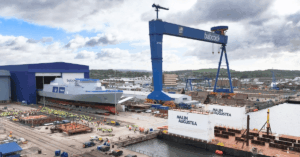
All 10 Crew Members Rescued After Coal Carrier Sinks Off Vietnamese Port
May 28, 2025
Armed Gang Ties & Beats Crew During Violent Ship Robbery At Mongla Port
May 28, 2025

The Royal Navy’s next-generation warship, HMS Venturer, has officially emerged from its massive build hall in Rosyth, Scotland.
After more than three years of assembly behind closed doors, the ship was revealed to the public as the 28-metre-high doors of the hall opened for the first time.
The 139-metre-long vessel was slowly moved outside over nearly 12 hours using specially designed transport cradles. The ship, weighing 5,700 tonnes, is now positioned on the hardstanding area beside the dock at Babcock’s Rosyth facility.
HMS Venturer is the first of five Type 31 frigates being built under a £10 billion plan to modernise the Royal Navy and replace the aging Type 23 fleet. These new ships fall under the Inspiration-class, each named after historic Royal Navy vessels with remarkable legacies.
The construction of HMS Venturer took place entirely within the purpose-built Venturer assembly hall, which is large enough to accommodate two ships at once. This has allowed work to continue simultaneously on HMS Active, the second frigate in the programme. The next ship in line, HMS Formidable, will now move into the space recently vacated by Venturer.
Throughout the construction phase, nearly 1,400 workers were engaged on site, with close to as many supporting from different locations across the UK. Teams of shipwrights, welders, electricians, engineers, naval architects, and Royal Navy personnel have collectively contributed hundreds of thousands of hours to bring the ship to this stage.

Now that Venturer is outside the hall, preparations will continue for her float-off, expected later this summer. The ship will be placed on a special barge and lowered into the dock at Rosyth. Once in the water, installation of key systems, sensors, and weapons will begin, moving the ship closer to operational readiness.
Commander Chris Cozens, Senior Naval Officer of HMS Venturer, explained that while the ship’s company had watched the build progress from the keel up, this was the first time the Royal Navy and Babcock were able to publicly showcase the vessel.
He said that this rollout was an important moment for both the ship and the overall Type 31 programme, bringing the Navy closer to having a modern, versatile fleet that supports national security and global operations.
Executive Warrant Officer Lee ‘Rattler’ Morgan also shared his thoughts, stating that the size and potential of the ship are now much clearer as it steps into view. He expressed optimism that the new design and its opportunities would appeal to Navy personnel, adding that as the build matured, so did the ship’s crew, who are eager to explore new ways to run and manage the platform.
The Type 31 frigates are designed to be larger yet more efficient than the Type 23s they replace. While they are 60 percent bigger in size, they require only around 120 crew members, down from the 180 to 200 typically needed on the older frigates.
Babcock CEO David Lockwood described the rollout as a proud milestone for everyone involved, crediting the hard work and dedication of the workforce. He stated that these warships are built for long-term use with flexibility and future upgrades in mind, ensuring the Royal Navy remains capable in global operations for decades to come.
Reference: Royal Navy
Source: Maritime Shipping News


